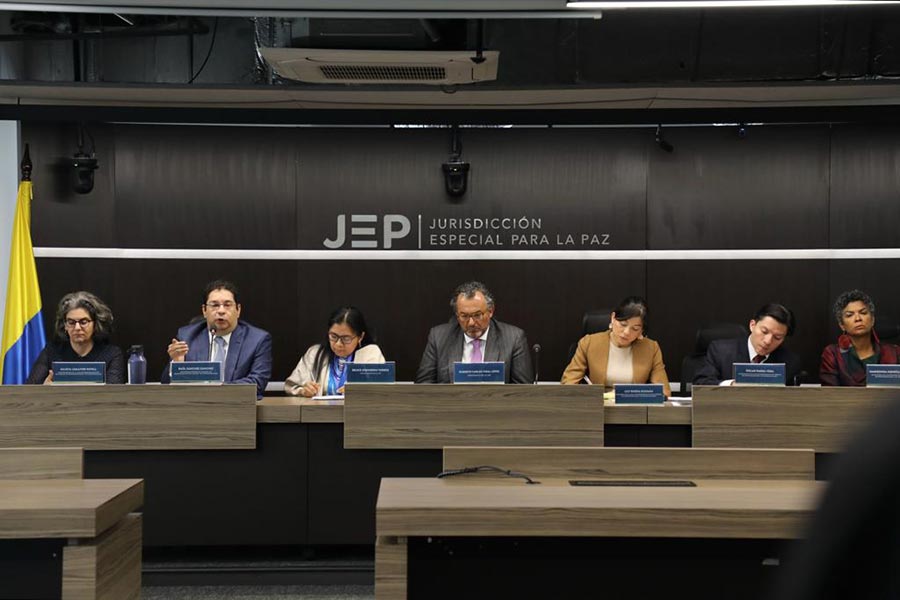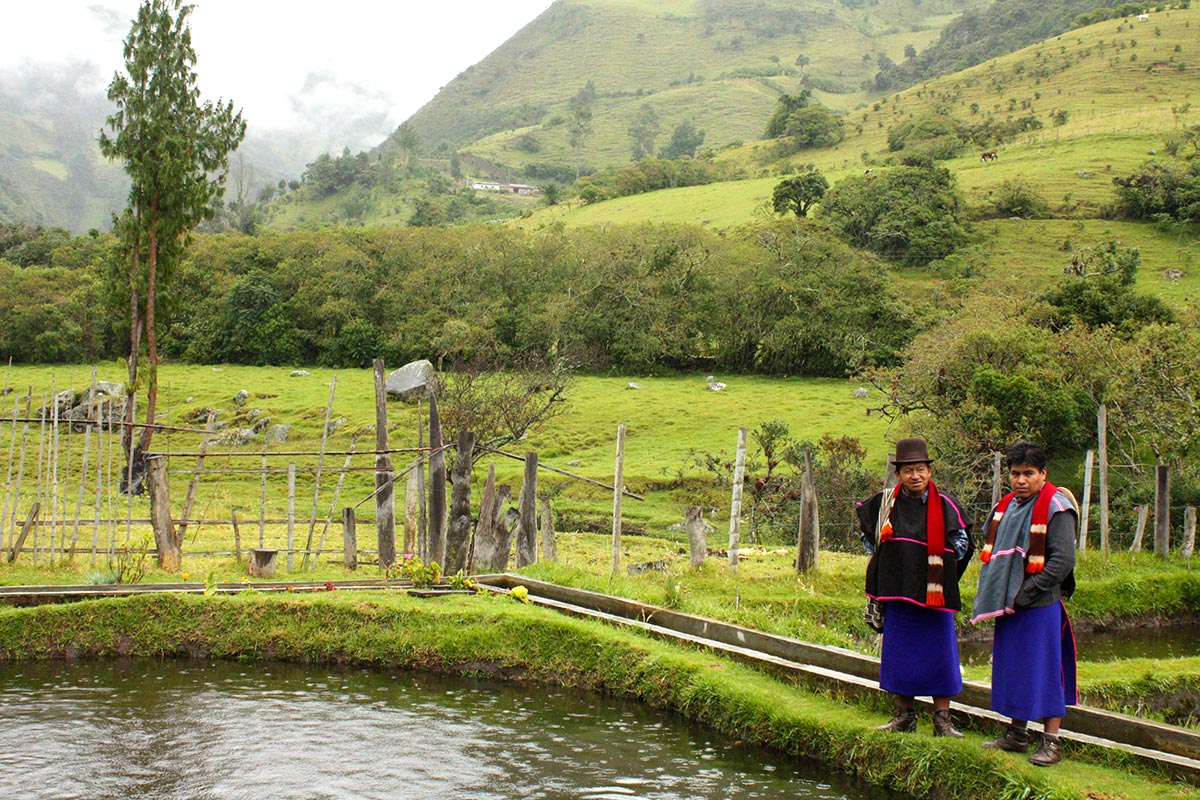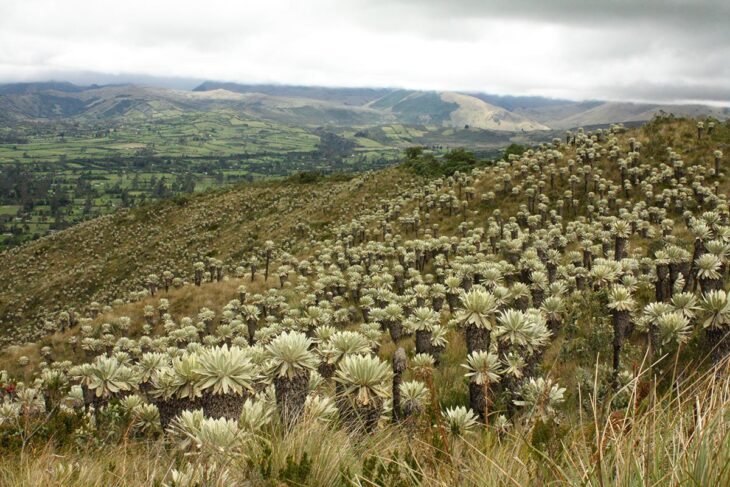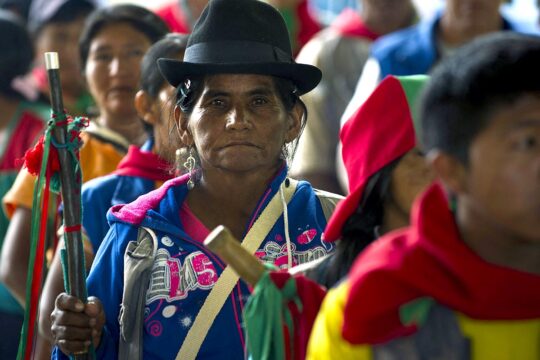When Colombia’s Special Jurisdiction for Peace (JEP) unveiled its fifth indictment a month ago, it marked several milestones: it accused mid-level commanders of the former Revolutionary Armed Forces of Colombia (FARC) for the first time, unveiled its first investigation focused on regions rather than specific crimes, and put the spotlight on thousands of victims belonging to two ethnic minorities. It was also the first time that the judicial arm of Colombia's transitional justice system held an armed actor responsible for environmental damage.
According to the JEP, the two guerrilla structures operating in the departments of Cauca and Valle del Cauca, in Colombia’s southwest, were responsible for the destruction of high mountain ecosystems and the degradation caused by illegal mining and coca cultivation. After describing it as a damage "whose imprint may be totally irreversible", the tribunal deemed it a war crime and presented charges against ten local guerrilla commanders.
It was a momentous decision, at a time when discussions on the merit of including 'ecocide' as a fifth international crime in the Rome Statute continue at a global level. In Colombia, it was the first time that the transitional justice stemming from the 2016 peace agreement issued a legal decision addressing the impact of the internal armed conflict on the environment, a landmark in the world's second most biodiverse country. It was its way of fulfilling the promise that, as the indictment says, "transitional justice is also environmental justice."
It was not, however, a decision without controversy. Three of the seven justices that comprise the JEP's Acknowledgment Chamber, which is in charge of documenting the cases presented by the tribunal, departed from the majority decision and presented strong dissenting opinions questioning this legal qualification. Two more submitted clarifications of vote defending it. This unusual situation underscores how, despite the historic nature of the peace tribunal's investigation of ecological crimes, there is marked internal disagreement over how it should punish them.

"The impact of war on nature"
In his indictment, justice Raúl Sánchez focused on documenting two criminal economies in that region that, in his opinion, "summarize the impact of war on nature." On the one hand, FARC promoted illegal gold mining using backhoes that destroy river basins and sediment river beds, in mining facilities that even used toxic and internationally banned chemicals such as mercury to separate the mineral from the rock. On the other, the guerrillas promoted the cultivation of coca to produce cocaine, in what he called a "vicious circle" of deforestation and agricultural land use changes.
Both were, says the JEP, key sources of financing for FARC and activities so complementary that they coincide in up to two-thirds of Cauca, carried out "without any environmental management or harm reduction rules”. In general, the decision says, rebels participated indirectly, charging extortion or commercializing the product, although the Acknowledgment Chamber also says it documented cases of FARC members who owned machinery.
The sum of these damages led the JEP to conclude that, in that region, FARC were the "de facto environmental authority" and "didn’t have an active policy to prevent the damages caused". In its words, their "ambiguous attitude (...) ended up generating serious harm to the environment due to their conduct, permissive in some cases and direct in others, with human acts that broke the environmental balance of the region".
In addition, the JEP accused FARC of causing multiple damages to páramos (alpine tundras), a high mountain ecosystem that only exists in a handful of tropical countries and is considered strategic for its water richness. According to the tribunal’s account, the guerrillas mowed down its carbon-rich plant cover to set up camps and planted landmines to stop army advances, the explosion of which affected the surroundings. In one section, it highlighted the destruction of frailejones (friar plants), emblematic and hairy plants that retain large amounts of water and whose almost ghostly silhouette is spotted in the fog. "It grows one centimeter per year and recovering specimens can take up to 200 years," the JEP explained, stressing that this fact proves the severity and magnitude of the damage.
"The environment, as a broad concept, but also represented by living or sentient beings, witnessed an attack against its integrity driven by armed actors’ greed," it concluded.
The territory as a victim
In addition to documenting the environmental footprint of these two criminal economies and the damage to páramos, the JEP elaborates on another novel idea. Not only the indigenous and Afro-descendants were victims of the armed conflict but also the territories they inhabit, in what it called "a crime of a multi-offensive nature".
According to the indictment, FARC's various actions - from assassinations to confinements and displacements - caused countless collective and individual damages to ethnic minorities, who enjoy special constitutional protection in Colombia. Citing examples taken from reports submitted by various peoples and communities, the JEP contended that the guerrillas weakened their governance structures, facilitated the loss of identity traits such as language or dress, restricted access to their sacred sites and weakened their local economies. This led it to conclude that there was "a systematic affectation of the right to cultural identity of ancestral peoples, farmer communities and Afro-descendants".
Although it doesn’t develop the idea in depth, the accusation ties these affectations to the worldview of many ethnic peoples in Colombia, for whom the territory is as much an integral part of the community as the people who inhabit it. Therefore, indigenous reservations and Afro community councils, rather than being just "places of dispute on account of geographical traits that constitute strategic advantages in war", were part of the "thousand or hundred-year legacy" of the 10 indigenous peoples and dozens of Afro communities affected. In this logic, illegal mining matters not just because it "dealt a severe blow to the enormous biodiversity of the area," says the JEP, but also because it "altered the relationship of communities with their ancestral lands”.
In some passages, it would seem that the JEP didn’t bring its investigation to its ultimate consequences. In one part, the indictment mentions that leaders of the Gabriel Galvis Mobile Column acknowledged planting landmines in the páramo around San Rafael lagoon, which the Kokonuko tribe consider a sacred site. The JEP team didn’t realize that this lagoon - also called Andulvio - is located within Puracé National Park, a fact that makes the confession even more serious given that national parks also enjoy special constitutional protection in Colombia.

Environmental damage as a war crime
In investigating the environmental harm caused by the FARC in the southern Andes, the JEP faced a significant hurdle: the Rome Statute – the treaty that established the International Criminal Court of which Colombia is a member – contemplates that lasting, extensive and serious damage caused to the environment can constitute a war crime in the midst of an international conflict, but it says nothing about internal armed conflicts such as the one Colombia experienced for half a century. It is a dilemma reinforced by demands from ethnic groups and environmental scientists on the need to address the impact of war on the country's ecosystems and national parks.
This legal grey area meant that there was no single, clear path to charge the former FARC commanders for their environmental destruction. Justice Raúl Sánchez decided to classify these acts as a war crime following a three-pronged line of argument. In his central thesis, he reasoned that it fits within the international crime of destroying or seizing the property of an adversary, since the environment is a civilian property and an attack on natural resources constitutes one against the State as its adversary.
Secondly, he contended that Colombian law prohibits causing extensive, lasting and serious damage to the environment, that this entails individual criminal liability for whoever causes it and that the international criteria are met - following the Tadić test of the International Criminal Tribunal for the former Yugoslavia - to consider it a war crime. Finally, he argued that environmental crimes should not be prone to amnesties and defended that nature can also be considered a victim, in a country where other non-human entities - such as the Colombian Amazon or the Atrato River in the Pacific - have been declared subjects of rights by high courts.
"A non-existent crime in international criminal law"
Justice Sánchez’s legal argumentation spurred a heated debate within the Acknowledgment Chamber, which extends to another regional case focusing on the southern region of Nariño and also soon to see an indictment. Unlike what had happened in previous indictments, three of its seven magistrates wrote partial dissenting opinions in which they disputed the indictment’s methodology and some of its conclusions.
The issue generating the most noise were environmental damages. Julieta Lemaitre, the justice in charge of the case against the FARC for kidnapping, defended that the accusation "makes a careful and well-intentioned analysis of environmental degradation" but stated that it "creates a crime that does not exist in international criminal law". In her view, if environmental degradation was - as the decision says - caused mainly by illicit crops and illegal mining, those behaviours were not an international crime at the time the accused committed them and, instead, are privy to amnesties. She also disputed the notion that the environment is a State asset and pointed out that, if it were, it wouldn’t belong to ethnic peoples.
Catalina Díaz, in charge of the “false positives” case, emphasized that it "provides a solid basis for designing redress measures that take into account the complexity of the effects on nature," but contended that it suffers from "serious argumentative flaws" in classifying them as war crimes. Among others, she signalled that there is no evidence that FARC attacked ecosystems with the intention of diminishing the combat capacity of their adversary and that the causal links of the accused with the criminal economies that depredate the environment are not proven. And Lily Rueda, in charge of the child recruitment case against FARC, noted that she "doesn’t deem it possible to qualify illegal mining or illicit crops as means or methods of combat". Like her two colleagues, she considered that the accusation describes two criminal activities that are privy to amnesties as war crimes, in conflict with the peace deal’s idea of granting the broadest amnesty legally possible.
In sum, all three contended that the indictment fails to prove that there is serious, extensive and lasting damage, that the defendants were directly responsible for it and that they did so through actions in violation of international humanitarian law.
A cross-cultural justice?
Two other magistrates defended the accusation’s conclusions. Oscar Parra, who also leads the extrajudicial executions case, added additional ways to deem it a war crime, including that FARC omitted its obligations as an occupying power in the territories where it acted as de facto environmental authority and that "the appropriation of natural resources, soils, rivers and other water sources or elements of the complex interrelationship of the environment" can be considered a form of pillage, punishable with the harshest penalty in both types of conflict.
Belkis Izquierdo, the JEP’s new vice-president and the justice in charge of the Nariño regional case, argued that it is a good example of the "horizontal cross-cultural dialogue" that the peace tribunal must weave with the legal systems of ethnic peoples and that its decisions must incorporate those worldviews. That implies, she said, recognizing the "intimate" and "harmonious" relationship they have with the territory, "essential for their physical, cultural and spiritual survival."
"More than understanding the damage committed against landscapes or natural resources, it is necessary to have a relational approach that considers the rupture of socio-ecological relations at multiple scales and temporalities," Izquierdo, an Arhuaca indigenous woman and the first indigenous woman to reach a high court in Colombia, wrote. She went on to suggest a legal path that she considers more suitable than the one chosen by Sánchez: that FARC's actions against sacred sites constitute the war crime of destruction of cultural property or places of worship. Not to consider it as such, she wrote, entails that ethnic peoples’ visions and experiences are not reflected in the accusation.
The debate Izquierdo raises is not an isolated one, but reflects that of her own case, which deals with crimes committed against dozens of Afro community councils and several Awá reservations - the country’s most victimized indigenous people - in the Pacific region bordering Ecuador. She presented her proposed indictment against another group of local guerrilla commanders to the Chamber in last October, as two people familiar with the case confirmed to Justice Info, but it has not yet been approved by her colleagues amid similar legal debates.
Symbolic crimes
How the JEP - the first high court in Colombia to have indigenous magistrates - ends up resolving this legal debate will have implications going forward. Not only will it be critical for the other two regional cases already under investigation, but also to decide what to do with the claims brought forward by other victims and the environmental sector.
As Justice Info reported, a group of scientists and environmental experts asked the tribunal to examine how national parks and the public officials looking after them were attacked by FARC, including at least one case - the murder of park ranger Martin Duarte in the Macarena Range National Park - in which one of the alleged perpetrators is awaiting the JEP’s decision on his legal status. The private sector has also called for 3,659 attacks against oil infrastructure in the last three decades, which polluted rivers and aquifers, including more than 700 carried out by FARC in Nariño and neighbouring Putumayo, to be addressed. Both are crimes of high symbolic value for which the former guerrillas have yet to answer.
It may also mark other transitional processes in the future. Especially because Gustavo Petro’s administration initiated peace talks with the National Liberation Army (ELN), another guerrilla still in arms that has historically focused its military activity on blowing up oil pipelines as a way to fight against the economic model. If negotiations with this rebel group are successful, its members could be brought before a transitional justice mechanism - whether it is the JEP or a new one - and thus be held accountable for these acts of war and the environmental damage they caused.
"Transitional justice internationally has had to address and provide legal responses to demands for justice that hadn’t been satisfied by the ordinary justice system. What is at stake here is the possibility that the JEP take into account the environmental and territorial justice demands of victims," says Gloria Lopera, a Jorge Tadeo Lozano University professor and former Constitutional Court senior law clerk who has studied the legal history of indigenous territories. "Those environmental damages and the appropriation of the territory with an extractive and criminal motivation are not something secondary, but part of what has fuelled the conflict and kept it going."








